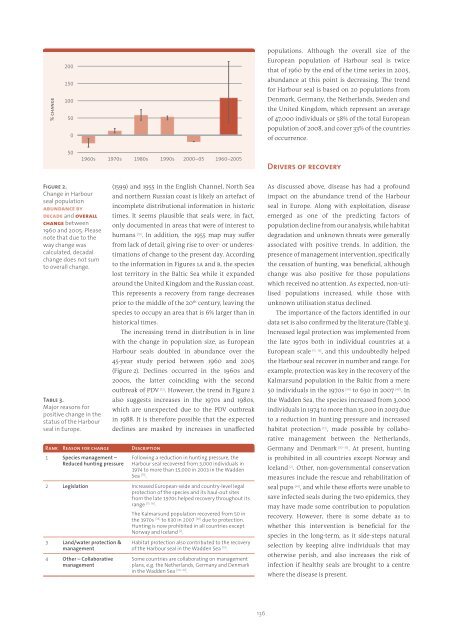130925-studie-wildlife-comeback-in-europe
You also want an ePaper? Increase the reach of your titles
YUMPU automatically turns print PDFs into web optimized ePapers that Google loves.
% change<br />
200<br />
150<br />
100<br />
50<br />
0<br />
populations. Although the overall size of the<br />
European population of Harbour seal is twice<br />
that of 1960 by the end of the time series <strong>in</strong> 2005,<br />
abundance at this po<strong>in</strong>t is decreas<strong>in</strong>g. The trend<br />
for Harbour seal is based on 20 populations from<br />
Denmark, Germany, the Netherlands, Sweden and<br />
the United K<strong>in</strong>gdom, which represent an average<br />
of 47,000 <strong>in</strong>dividuals or 58% of the total European<br />
population of 2008, and cover 33% of the countries<br />
of occurrence.<br />
50<br />
1960s 1970s 1980s 1990s 2000–05 1960–2005<br />
Drivers of recovery<br />
Figure 2.<br />
Change <strong>in</strong> Harbour<br />
seal population<br />
abundance by<br />
decade and overall<br />
change between<br />
1960 and 2005. Please<br />
note that due to the<br />
way change was<br />
calculated, decadal<br />
change does not sum<br />
to overall change.<br />
Table 3.<br />
Major reasons for<br />
positive change <strong>in</strong> the<br />
status of the Harbour<br />
seal <strong>in</strong> Europe.<br />
Rank Reason for change Description<br />
1 Species management –<br />
Reduced hunt<strong>in</strong>g pressure<br />
(1599) and 1955 <strong>in</strong> the English Channel, North Sea<br />
and northern Russian coast is likely an artefact of<br />
<strong>in</strong>complete distributional <strong>in</strong>formation <strong>in</strong> historic<br />
times. It seems plausible that seals were, <strong>in</strong> fact,<br />
only documented <strong>in</strong> areas that were of <strong>in</strong>terest to<br />
humans [19] . In addition, the 1955 map may suffer<br />
from lack of detail, giv<strong>in</strong>g rise to over- or underestimations<br />
of change to the present day. Accord<strong>in</strong>g<br />
to the <strong>in</strong>formation <strong>in</strong> Figures 1a and b, the species<br />
lost territory <strong>in</strong> the Baltic Sea while it expanded<br />
around the United K<strong>in</strong>gdom and the Russian coast.<br />
This represents a recovery from range decreases<br />
prior to the middle of the 20 th century, leav<strong>in</strong>g the<br />
species to occupy an area that is 6% larger than <strong>in</strong><br />
historical times.<br />
The <strong>in</strong>creas<strong>in</strong>g trend <strong>in</strong> distribution is <strong>in</strong> l<strong>in</strong>e<br />
with the change <strong>in</strong> population size, as European<br />
Harbour seals doubled <strong>in</strong> abundance over the<br />
45-year study period between 1960 and 2005<br />
(Figure 2). Decl<strong>in</strong>es occurred <strong>in</strong> the 1960s and<br />
2000s, the latter co<strong>in</strong>cid<strong>in</strong>g with the second<br />
outbreak of PDV [12] . However, the trend <strong>in</strong> Figure 2<br />
also suggests <strong>in</strong>creases <strong>in</strong> the 1970s and 1980s,<br />
which are unexpected due to the PDV outbreak<br />
<strong>in</strong> 1988. It is therefore possible that the expected<br />
decl<strong>in</strong>es are masked by <strong>in</strong>creases <strong>in</strong> unaffected<br />
Follow<strong>in</strong>g a reduction <strong>in</strong> hunt<strong>in</strong>g pressure, the<br />
Harbour seal recovered from 3,000 <strong>in</strong>dividuals <strong>in</strong><br />
1974 to more than 15,000 <strong>in</strong> 2003 <strong>in</strong> the Wadden<br />
Sea [13] .<br />
2 Legislation Increased European-wide and country-level legal<br />
protection of the species and its haul-out sites<br />
from the late 1970s helped recovery throughout its<br />
range [15, 16] .<br />
The Kalmarsund population recovered from 50 <strong>in</strong><br />
the 1970s [34] to 630 <strong>in</strong> 2007 [40] due to protection.<br />
Hunt<strong>in</strong>g is now prohibited <strong>in</strong> all countries except<br />
Norway and Iceland [2] .<br />
3 Land/water protection &<br />
management<br />
4 Other – Collaborative<br />
management<br />
Habitat protection also contributed to the recovery<br />
of the Harbour seal <strong>in</strong> the Wadden Sea [13] .<br />
Some countries are collaborat<strong>in</strong>g on management<br />
plans, e.g. the Netherlands, Germany and Denmark<br />
<strong>in</strong> the Wadden Sea [30–33] .<br />
As discussed above, disease has had a profound<br />
impact on the abundance trend of the Harbour<br />
seal <strong>in</strong> Europe. Along with exploitation, disease<br />
emerged as one of the predict<strong>in</strong>g factors of<br />
population decl<strong>in</strong>e from our analysis, while habitat<br />
degradation and unknown threats were generally<br />
associated with positive trends. In addition, the<br />
presence of management <strong>in</strong>tervention, specifically<br />
the cessation of hunt<strong>in</strong>g, was beneficial, although<br />
change was also positive for those populations<br />
which received no attention. As expected, non-utilised<br />
populations <strong>in</strong>creased, while those with<br />
unknown utilisation status decl<strong>in</strong>ed.<br />
The importance of the factors identified <strong>in</strong> our<br />
data set is also confirmed by the literature (Table 3).<br />
Increased legal protection was implemented from<br />
the late 1970s both <strong>in</strong> <strong>in</strong>dividual countries at a<br />
European scale [15, 16] , and this undoubtedly helped<br />
the Harbour seal recover <strong>in</strong> number and range. For<br />
example, protection was key <strong>in</strong> the recovery of the<br />
Kalmarsund population <strong>in</strong> the Baltic from a mere<br />
50 <strong>in</strong>dividuals <strong>in</strong> the 1970s [34] to 630 <strong>in</strong> 2007 [40] . In<br />
the Wadden Sea, the species <strong>in</strong>creased from 3,000<br />
<strong>in</strong>dividuals <strong>in</strong> 1974 to more than 15,000 <strong>in</strong> 2003 due<br />
to a reduction <strong>in</strong> hunt<strong>in</strong>g pressure and <strong>in</strong>creased<br />
habitat protection [13] , made possible by collaborative<br />
management between the Netherlands,<br />
Germany and Denmark [30–33] . At present, hunt<strong>in</strong>g<br />
is prohibited <strong>in</strong> all countries except Norway and<br />
Iceland [2] . Other, non-governmental conservation<br />
measures <strong>in</strong>clude the rescue and rehabilitation of<br />
seal pups [43] , and while these efforts were unable to<br />
save <strong>in</strong>fected seals dur<strong>in</strong>g the two epidemics, they<br />
may have made some contribution to population<br />
recovery. However, there is some debate as to<br />
whether this <strong>in</strong>tervention is beneficial for the<br />
species <strong>in</strong> the long-term, as it side-steps natural<br />
selection by keep<strong>in</strong>g alive <strong>in</strong>dividuals that may<br />
otherwise perish, and also <strong>in</strong>creases the risk of<br />
<strong>in</strong>fection if healthy seals are brought to a centre<br />
where the disease is present.<br />
136


